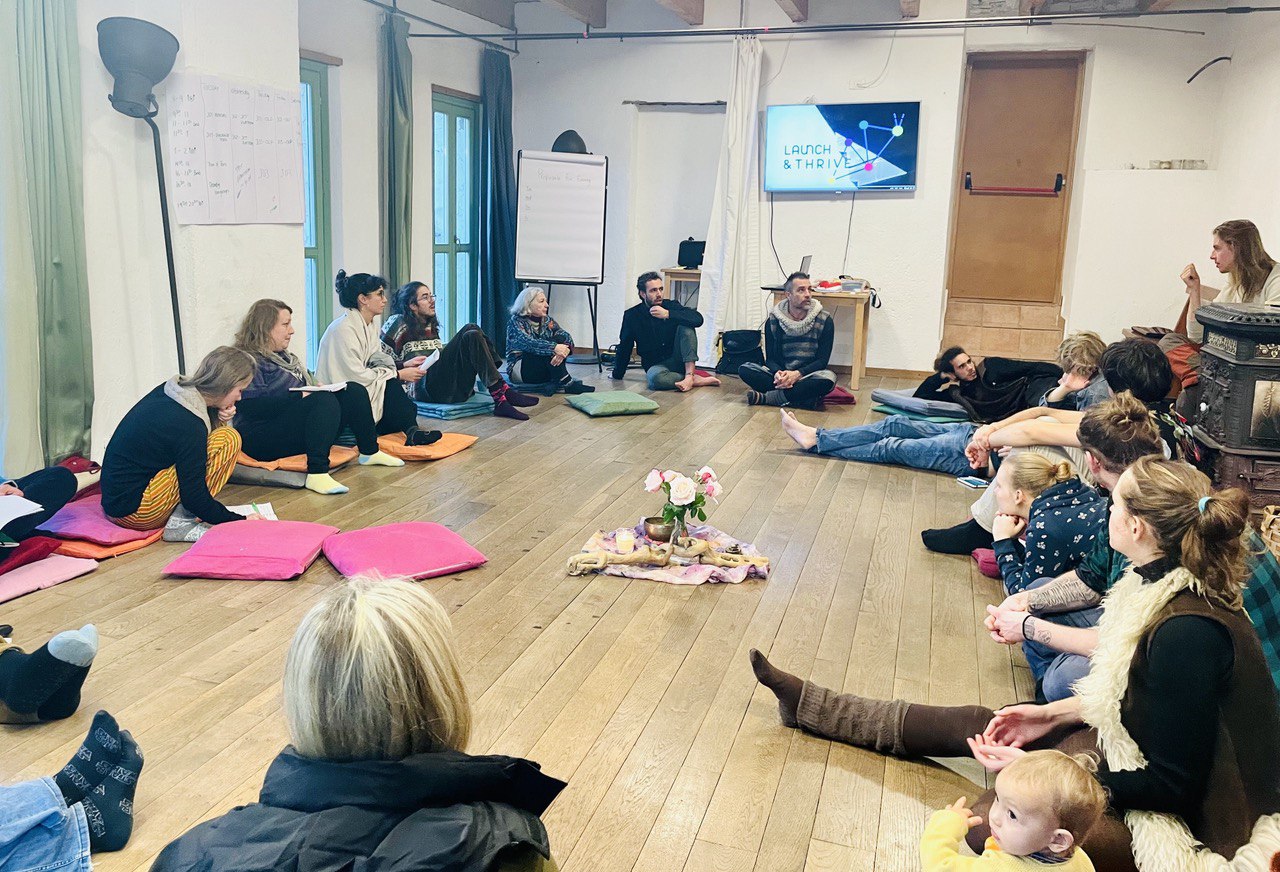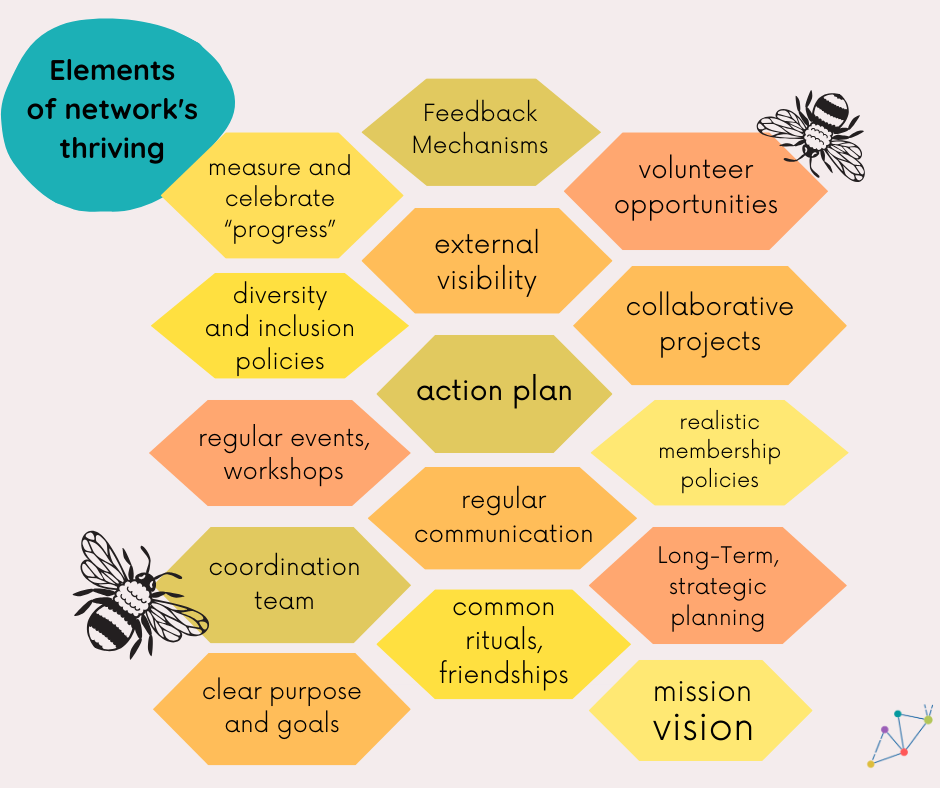THRIVING: Sustaining the connections
| Site: | GEN Europe's learning platform |
| Course: | Launch & Thrive Online Learning Package |
| Book: | THRIVING: Sustaining the connections |
| Printed by: | Guest user |
| Date: | Tuesday, 28 October 2025, 6:37 PM |
Description

1. How to help network thrive?
Maintaining meaningful and sustainable connections among network members engaged in managing the network-organizations is crucial for the success of collective efforts. Thriving means that you not only keep the network existing but - most importantly - you take part in its organic development. In the context of networks, the term "thriving" refers to a state where the community survives, prospers, grows, and flourishes. It signifies a higher level of success and well-being beyond mere survival. When a network is described as thriving, it typically means that the community of networkers is achieving its intended goals and is experiencing positive outcomes in various aspects of its existence.
It is however important to remember that regenerative development is different from constant progress! The intention is to adapt as well to the member's needs and wishes and sometimes it means taking a step back and reformulating the vision and mission of the network!

2. Elements of network's thriving
Below we provide a sort of checklist that includes the elements and steps covered in this course which are particularly important for the network to flourish. It is crucial to take into account not only the presence of the specific element but also the “how” of its development within the team and the network.
- Crucial is to have a Clear Mission, vision and Goals. Ensure that all members understand the purpose and goals of the network or organization. This clarity helps in keeping everyone motivated and focused on the same objectives. Written and outspoken arrangements, rules, regulations, and networking practices should resonate with team socio-cultural expectations as well as spiritual belief systems to support their process of seeking and maintaining connections.
- Regular Communication is essential. Use a variety of channels, including emails, newsletters, social media, and in-person meetings, to keep members informed about the organization's activities and updates in the environmental field.
- Create Online Platforms such as a website or a private social network group, where members can connect, share information, and discuss relevant topics. This can also serve as a repository for resources and documents.
- Encourage and facilitate Collaborative Projects Working together on specific initiatives can help build stronger connections among members. These projects should align with the organisation's mission and allow members to apply their skills and knowledge.
- Organize regular Events, Workshops and webinars to bring members together. These events can be educational, networking-focused, or a combination of both. Consider hosting guest speakers and experts to share insights and engage members.
- Provide Volunteer Opportunities: Give members the chance to get involved in hands-on activities, such as clean-up events, tree planting, or advocacy campaigns. Engaging in real-world projects can create a strong sense of purpose and community.
- Implement Feedback Mechanisms to allow members to express their opinions and suggest improvements. A feeling of being heard can strengthen the commitment of members.
- Offer tangible Membership Benefits benefits to members, such as access to exclusive resources, discounts, or recognition for their contributions. This can help retain and engage members.
- Ensure that the organization is applying Diversity and Inclusion and welcomes people from diverse backgrounds. Diversity can lead to a broader perspective and more innovative solutions.
- Establish Mentorship Programs that pair experienced members with newcomers. This can help transfer knowledge, build relationships, and integrate new members into the community.
- Take care of Leadership Development. Provide opportunities for members to take on leadership roles within the organization. This not only shares the responsibility but also empowers individuals to take ownership of the organization's success.
- Measure and Celebrate Progress, track and celebrate achievements. Recognize members' contributions and milestones, whether they are individual or organizational.
- Long-Term Planning: Develop a strategic plan that outlines the organization's vision, mission, and goals for the long term. Having a clear roadmap can keep members committed to the cause.
- Be open to change and adapt to evolving circumstances and challenges. Environmental issues are dynamic, and the organization should be flexible enough to address new concerns.
- Establish Partnerships. Collaborate with other environmental organizations and stakeholders. Partnering with like-minded groups can expand your network and resources.

3. How to revive the network?
Is it easier to launch the new network or to revive the existing one? The answer is naturally complex and it depends - among others where the network is in its development, what is the will and vision of the engaged group.
If you happened to observe a loosening of the relations and organizational structures in your network, or you can even admit that your network is going through some kind of crisis - IT’S JUST GREAT! Really! Because this is a great moment to rethink and redesign the existing identity and strategy of your network. We are here to guide you in this process.
It might have been more advantageous and healthy if your collective or your network had conducted a more proficient evaluation of potential members, better planning, more outreach initially or implemented measures to prevent drifting away from fundamental principles…the list of assumptions and possible scenarios of such character can be endless! What is for sure, this transformation has occurred and is irreversible. And…that’s okay! It is probably what was the most optimal option possible at a certain time of the network’s existence.
Now, what courses of action are available to you? Given that the group is not aligned with your envisioned developments, guidance in this course centres around the possibilities for you as an individual or a compact team to pursue. Generally, right now what is needed the most is clarity, honesty, good leadership and: transformation!
Invitation to the regular meetings and forums:
- Bring into play all possible efforts to cultivate and invigorate the existing well-being. Infuse it with positivity and contribute to creating a rewarding environment for its participants. Positive vibes will enhance its appeal and entice others to become part of the community.
- Given that there are ongoing meetings, reach out to members who have been absent and extend a personal invitation for their participation. Express your genuine interest in having them attend. If approaching them without sounding judgmental is a challenge, consider enlisting someone else to initiate the conversation. Alternatively, you can divide the membership list among the regular attendees, with each person engaging in discussions with a few individuals they share good relationships.
- Set an example through your own interactions with others.
4. What resilience has to do with thriving?
One of the most important notions when considering the thriving of the network is Resilience.
Resilience refers to the capacity of a system or community to withstand and adapt to disturbances, shocks, or challenges while maintaining its essential functions, identity, and overall integrity. It involves the ability to absorb and respond to various external and internal pressures, such as leadership changes, resource constraints, social conflicts, or natural disasters, and to recover or adapt in ways that allow the system to continue functioning effectively.
Many studies were conducted in ecological communities and ecovillages analysing the concept of resilience, like Auroville, and Cloughjordan. These communities encounter a variety of disturbances and threats, and their ability to navigate and overcome these challenges is a key measure of their resilience.
Various factors and enablers of resilience, identified are such as leadership, diversity, openness, modularity, self-organization, and a shared guiding philosophy or ideology. These factors collectively contribute to the community's ability to adapt, reorganize, and maintain its core principles and objectives, even in the face of unexpected or unprecedented disruptions.
Resilience is not merely about withstanding shocks; it's about embracing change, learning, and evolving to ensure that the community remains true to its purpose, vision, and values over time. In this context, resilience is a dynamic quality that allows intentional communities to navigate the complex and ever-changing challenges they encounter while continuing to pursue their utopian or intentional goals.
5. Useful Resources
Here we provide a list of handy materials to deepen the knowledge of the thriving of the network: